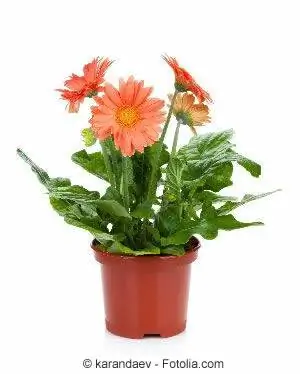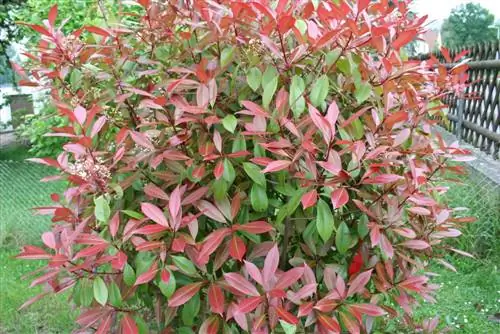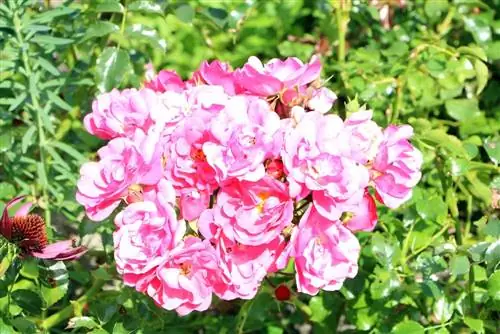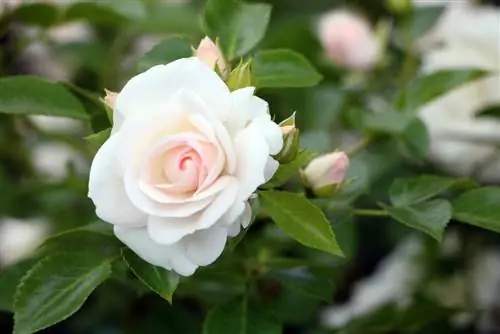- Author admin [email protected].
- Public 2023-12-17 03:39.
- Last modified 2025-06-01 06:48.
The gerbera has a sunny disposition. It is originally native to warm and tropical areas of South Africa and Asia. The potted gerbera is usually a hybrid of many different natural species. Their long-stemmed basket flowers unfold in a wide variety of colors. It is extremely affordable and brings a lot of joy to the viewer. It looks great on the flower window. Standing alone on the dining or coffee table, it noticeably loosens up the atmosphere in the room. And in summer, potted gerberas in all color variations make every balcony a cheerful splash of color.
Location
The potted gerbera loves bright light, but cannot tolerate the blazing sun. You should remember this simple wisdom when caring for the potted gerbera, which is not particularly easy to care for. It is important to note that it is very sensitive to high heat. It should never be exposed to direct sunlight all day long. Even the midday heat at the flower window can cause burns, which will cause long-term damage. A location where the morning or afternoon sun can be absorbed is ideal. A little distance from the flower window protects against midday heat. If you don't have these options, a sunny spot in the room would be perfect. It is also important to ensure that the room is ventilated regularly and well, as the potted gerbera cannot get hot, stagnant air, especially in summer. From the summer months onwards, when the temperature regularly reaches over 15 °C at night, you can put it on the balcony with a clear conscience. But here too it is important to choose a place that is bright but not too sunny.
Nutrient intake
Regular watering is necessary to ensure optimal care of the potted gerbera. It should be watered every one to two days so that the soil always remains moist. However, waterlogging should be avoided. You should choose a planter that has a free space at the bottom for collecting excess water. Tip: If the planter is larger than the plant pot, raise the base with an upturned saucer or other slanted object. This means that the plant pot is always a little higher and is not immediately in backwater if too much has been watered. Regular checks still make sense, especially if you don't have the famous green thumb. Add a little liquid fertilizer to the irrigation water every week in summer. The potted gerbera will thank you with strong and beautiful flowers from April to September.
Tip:
It is also very grateful if you spray it regularly with a plant humidifier. This suits their tropical habits and protects against dried out leaves if it gets a little hotter.
Wintering
From autumn onwards, the potted gerbera loses its strength. Then the perennial, but not winter-hardy plant should be moved to a suitable place to overwinter. It then goes into a resting phase, which allows it to bloom vigorously again from spring. To do this, you should look for a room that ensures a temperature of around 10 °C. For example, an unheated but bright winter garden or the window of an unheated hallway looks good. There should definitely be enough daylight. Under no circumstances should the temperature exceed 15 °C, as this will disrupt the resting phase. During this time, around October to March, the potted gerbera is only watered lightly every 14 days. Fertilizer is not supplied to the plant during the dormant phase.
Repotting and plant substrate
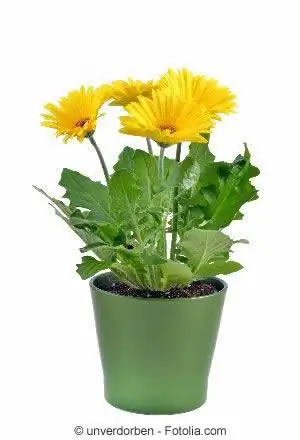
At the beginning of spring, the potted gerbera is awakened from its hibernation. However, you should only repot them if the flower pot is visibly no longer able to cope with the roots. Otherwise, it's better to avoid stressing the plant. The slightly larger pot, preferably made of clay and always with a drain at the bottom, should be filled with the right substrate. The potted gerbera needs a loose soil that allows nutrients to pass through, stores and gives the roots the opportunity to develop easily. Plant granules made from clay mixed with a little sandy soil work particularly well here. Adding volcanic rock such as perlite also ensures that the soil does not become too solid after a lot of watering. The soil, on the other hand, can easily absorb and hold the irrigation water and nutrients from fertilizers. When using potting soil that is suitable for potted gerberas, it is better to use a pre-made and plant-specific product from a specialist retailer to avoid pests and pathogens.
Tip:
The potted gerbera can be propagated by dividing the rhizome. This actually makes sense, as plants that are too full for several years lose their bloom and color.
The so-called root division can be carried out during repotting. If you are growing your own gerbera plants from seeds, you can plant them in the soil from February onwards.
Disease infestation
Unfortunately, the potted gerbera can rarely be saved when it is attacked by disease. The location to be avoided in stagnant air can lead to gray mold in the already weakened plant. It becomes noticeable through gray, furry coating on leaves and stems. If you act quickly and remove the relevant leaves and stems and provide fresh air, the potted gerbera may be able to be saved. However, it is better to dispose of them before other plants are affected by the fungal disease. Gerbera rot is also particularly difficult for potted gerberas. The leaves become pale and turn brownish. This happens when there is too much watering and fertilization. Unfortunately, subsequently reducing the nutrient intake can no longer help.
Frequently asked questions
Which location is the right one?
The potted gerbera needs a light-flooded location. However, exposure to heat from blazing sun should be avoided. Likewise, heat build-up in rooms.
How often do you have to water the potted gerbera?
It needs to be watered daily. The soil should always be slightly moist. Waterlogging should be avoided.
How do you make the gerbera bloom again?
In order to help the gerbera repeatedly produce strong flowers, it is important to give it a break from October to March. This is guaranteed in a bright location and a temperature of approx. 10 °C, water a little every 14 days.
When do you transplant and what soil should you use?
In spring, after the rest period, it can be transplanted. The potted gerbera needs loose soil.
What you need to know about potted gerberas in brief
Origin and overwintering
- The heat-loving gerbera, which belongs to the Asteraceae family, is originally native to Asia and South Africa. That's why these perennial, herbaceous plants are also very sensitive to cold.
- In the garden you can overwinter them outdoors in mild areas: To do this, the very frost-sensitive plants need a very thick insulation layer made of leaves and twigs, which is covered with a net or foil and anchored in the ground.
Varieties
The varieties are divided into the large-flowered standard gerbera (with a flower diameter of approx. 12.5 cm), the small-flowered mini gerbera (with a flower diameter of less than 9 cm) and in speci alties. The potted gerbera is often the Barberton gerbera (Gerbera jamesonii) and varieties thereof: This species has strong orange-red flowers that are yellow in the middle. The Gerbera jamesonii can grow up to 60 cm wide and around 45 cm high. It produces flowers from April to September. Gerberas are available in many different color shades. There are species or varieties with flowers in white, cream, pink, yellow, orange, red, violet as well as those with bicolor flowers. The sun-loving plant should be given a very bright location.
- The new potted gerbera series with the unusual spelled name “Sundayz” is particularly suitable for use on terraces and balconies. This mini gerbera - the flower diameter is 5 to 7 cm - is available in the colors white, red, pink, orange, yellow and purple, each with a green center.
- This series also includes a color type with a black center and a mixture. The Sundayz Bicolor versions have a black center. There are plants with monochromatic red flowers as well as bicolored white/pink flowers.
Location and care
- The potted gerbera prefers temperatures around 20 °C in summer. In winter it should be a little cooler - around 12 to 15 °C.
- Potted gerberas should be planted in fresh, sandy potting soil. The plant substrate should never become completely dry during the summer months, but it should definitely not be too wet.
- Sometimes watering from below - i.e. into the planter - can make sense. After a few minutes, the water that has not been absorbed by the pot should be drained. Because the gerbera doesn't like waterlogging at all.
- The potted gerbera should be fertilized regularly at least once a month from spring to late summer. Alternatively, it can also be supplied with a long-term fertilizer.

